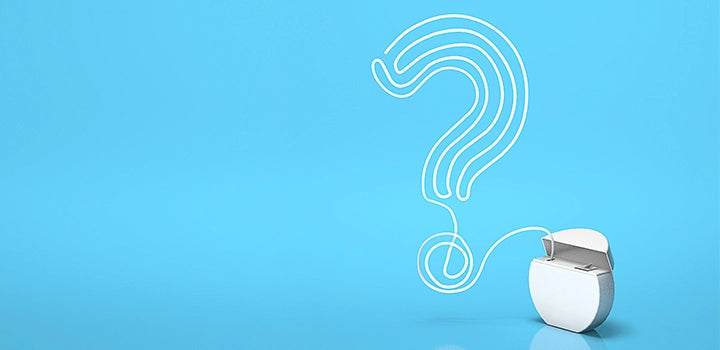You Should Floss Every Day. [Plus the “Why” Behind Flossing]
Don’t feel guilty for not flossing. Don’t think about your dental hygienist scolding you. If you aren’t flossing every day, you can start this healthy habit now. No shame!
10-30% of adults routinely floss. The overwhelming majority of adults floss once a week or less.
How often do you really need to floss? You really need to floss once a day to fight dental plaque that can lead to cavities and gingivitis. Some people floss twice a day, or after every meal, both of which are fine — as long as you aren’t irritating your gums.
Bookmark this article, so you can look back on why flossing is important and how often you should floss.
Why Flossing Is So Important
Flossing is so important to your dental care because food particles and dental plaque get in between your teeth, and toothbrushes don’t clean in between your teeth.
Leaving plaque in between your teeth may contribute to tooth decay, gum disease, tartar buildup, and bad breath.
It’s also important to buy the right floss. Many experts suggest the best dental floss is made with non-toxic ingredients, nylon, and unwaxed.
Flossing is a critical part of dental health, along with brushing your teeth with an electric, soft bristle toothbrushand avoiding sugary or acidic foods. According to the American Dental Association (ADA), you should also brush your teeth with a fluoride toothpaste.
How to Floss the Right Way
You should floss the right way to reduce your risk of cavities (tooth decay, dental caries) and periodontal disease (gum disease, periodontitis, gingivitis). Many people do not floss correctly. Not doing a thorough job lowers the benefits of flossing.
Here is a step-by-step guide on how to floss your teeth the right way:
- Use a string of floss that is 12-18 inches long. You need this length for added dexterity, stability, cleanliness, and comfort.
- Wrap the floss around your index and middle finger on each hand.
- Hold the floss taut with your thumbs and make a C- or U-shape.
- Gently slide the floss in between two teeth. Do not force the floss in and irritate the gums.
- Hug the side of each tooth and make light up and down motions to clean the plaque.
- Use a new section of floss for each tooth or rinse the floss off in between teeth, so you don’t simply deposit plaque elsewhere in your mouth.
Is flossing every day really necessary?
Flossing every day really is necessary. If you miss one day, no sweat. But if you purposefully miss a day, you’re more likely to miss another day, then another day, all of which can lead to untreated dental plaque, cavities, and gingivitis.
How often should you floss?
The ADA recommends cleaning between your teeth once a day with floss or an alternative interdental cleaner for healthy teeth and good oral hygiene.
Should you floss after every meal? You can floss after every meal. You can also use mouthwash or some water to rinse your mouth out of excess food particles that contribute to plaque and tooth decay.
Is it bad to floss twice a day? No, it is not bad to floss twice a day. You can floss multiple times a day if you experience excess interdental plaque. Be sure not to irritate your gums by prodding too much.
What time of day should you floss?
You should floss at a later time of day. At night when we go to bed, humans are more prone to dry mouth, which contributes to gum disease.
Flossing right before bed removes interdental plaque that may have formed during the day. This can counteract some of the bacterial overgrowth that may happen due to dry mouth while asleep.
Others choose to floss after their midday meal, which is acceptable.
Should you brush or floss first?
You should floss before you brush your teeth. This way, interdental plaque that is moved onto your teeth surface instead of removed can be brushed away.
According to a 2018 article, “flossing followed by brushing is preferred to brushing then flossing in order to reduce interdental plaque”.
Just like flossing is necessary to clean interdental plaque, toothbrushing should be done at a 45 degree angle, to clean plaque underneath your gum line. Taking care of your teeth involves flossing and brushing.
Alternatives to Dental Floss
These alternatives to dental floss are good for your oral health:
- Water flossers (such as Waterpik)
- Interdental brushes
- Dental picks
- Pre-threaded floss
- Super floss
Sources
- Kiran, S. D., Ghiya, K., Makwani, D., Bhatt, R., Patel, M., & Srivastava, M. (2018). Comparison of Plaque Removal Efficacy of a Novel Flossing Agent with the Conventional Floss: A Clinical Study. International Journal of Clinical Pediatric Dentistry, 11(6), 474. Full text: https://www.ncbi.nlm.nih.gov/pmc/articles/PMC6611534/
- Mazhari, F., Boskabady, M., Moeintaghavi, A., & Habibi, A. (2018). The effect of toothbrushing and flossing sequence on interdental plaque reduction and fluoride retention: A randomized controlled clinical trial. Journal of periodontology, 89(7), 824-832. Abstract: https://pubmed.ncbi.nlm.nih.gov/29741239/
- Lyle, D. M., Qaqish, J. G., & Schuller, R. (2013). Evaluation of the plaque removal efficacy of a water flosser compared to string floss in adults after a single use. J Clin Dent, 24, 37-42. Abstract: https://pubmed.ncbi.nlm.nih.gov/24282867/
- Ng, E., & Lim, L. P. (2019). An Overview of different interdental cleaning aids and their effectiveness. Dentistry journal, 7(2), 56. Full text: https://www.ncbi.nlm.nih.gov/pmc/articles/PMC6630384/


